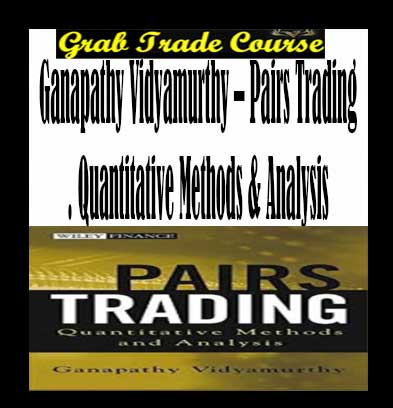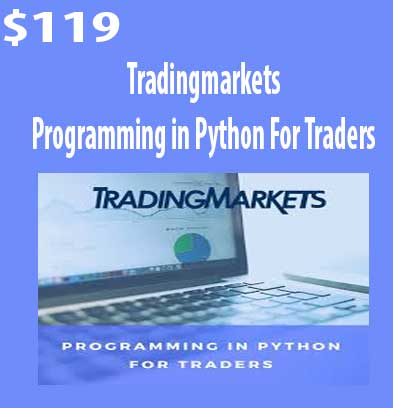Ganapathy Vidyamurthy – Pairs Trading. Quantitative Methods & Analysis
Description
Pairs Trading. Quantitative Methods & Analysis, Ganapathy Vidyamurthy – Pairs Trading. Quantitative Methods & Analysis, Pairs Trading. Quantitative Methods & Analysis download, Ganapathy Vidyamurthy – Pairs Trading. Quantitative Methods & Analysis review, Pairs Trading. Quantitative Methods & Analysis free torent
Ganapathy Vidyamurthy – Pairs Trading. Quantitative Methods & Analysis
The first in-depth analysis of pairs trading
Pairs trading is a market-neutral strategy in its most simple form. The strategy involves being long (or bullish) one asset and short (or bearish) another. If properly performed, the investor will gain if the market rises or falls. Pairs Trading reveals the secrets of this rigorous quantitative analysis program to provide individuals and investment houses with the tools they need to successfully implement and profit from this proven trading methodology. Pairs Trading contains specific and tested formulas for identifying and investing in pairs, and answers important questions such as what ratio should be used to construct the pairs properly.
Ganapathy Vidyamurthy (Stamford, CT) is currently a quantitative software analyst and developer at a major New York City hedge fund.
Table of Contents
Preface.
Acknowledgments.
PART ONE: BACKGROUND MATERIAL.
Chapter 1. Introduction.
The CAPM Model.
Market Neutral Strategy.
Pairs Trading.
Outline.
Audience.
Chapter 2. Time Series.
Overview.
Autocorrelation.
Time Series Models.
Forecasting.
Goodness of Fit versus Bias.
Model Choice.
Modeling Stock Prices.
Chapter 3. Factor Models.
Introduction.
Arbitrage Pricing Theory.
The Covariance Matrix.
Application: Calculating the Risk on a Portfolio.
Application: Calculation of Portfolio Beta.
Application: Tracking Basket Design.
Sensitivity Analysis.
Chapter 4. Kalman Filtering.
Introduction.
The Kalman Filter.
The Scalar Kalman Filter.
Filtering the Random Walk.
Application: Example with the Standard & Poor Index.
PART TWO: STATISTICAL ARBITRAGE.
Chapter 5. Overview.
History.
Motivation.
Cointegration.
Applying the Model.
A Trading Strategy.
Road Map for Strategy Design.
Chapter 6. Pairs Selection in Equity Markets.
Introduction.
Common Trends Cointegration Model.
Common Trends Model and APT.
The Distance Measure.
Interpreting the Distance Measure.
Reconciling Theory and Practice.
Chapter 7. Testing for Tradability.
Introduction.
The Linear Relationship.
Estimating the Linear Relationship: The Multifactor Approach.
Estimating the Linear Relationship: The Regression Approach.
Testing Residual for Tradability.
Chapter 8. Trading Design.
Introduction.
Band Design for White Noise.
Spread Dynamics.
Nonparametric Approach.
Regularization.
Tying Up Loose Ends.
PART THREE: RISK ARBITRAGE PAIRS.
Chapter 9. Risk Arbitrage Mechanics.
Introduction.
History.
The Deal Process.
Transaction Terms.
The Deal Spread.
Trading Strategy.
Quantitative Aspects.
Chapter 10. Trade Execution.
Introduction.
Specifying the Order.
Verifying the Execution.
Execution During the Pricing Period.
Short Selling.
Chapter 11. The Market Implied Merger Probability.
Introduction.
Implied Probabilities and Arrow-Debreu Theory.
The Single-Step Model.
The Multistep Model.
Reconciling Theory and Practice.
Risk Management.
Chapter 12. Spread Inversion.
Introduction.
The Prediction Equation.
The Observation Equation.
Applying the Kalman Filter.
Model Selection.
Applications to Trading.
Index.
Author Information
Ganapathy Vidyamurthy has been working in the financial markets for nearly a decade. During this time, he created the entire risk management software infrastructure for RBC Dominion Securities in New York, and built valuation models and automated execution strategies for UBS Warburg and JP Morgan Fleming. He is currently the principal of Himalaya Consulting. Beyond finance, Mr. Vidyamurthy’s interests range from discrete optimization to algorithmic music composition–a field in which he is often cited. Mr. Vidyamurthy has a master’s degree in electrical communication engineering from the Indian Institute of Science and a master’s degree from the Courant Institute of Mathematical Sciences of New York University
Our Policies
A. Product Quality
We will provide GOOD quality of courses fast. If any issue, email: [email protected].
We sure that your problem will be support as soon as possible.
B. Digital Shipping Proceess
After your payment, we will review your payment, Then, we will send you PCLOUD LINK OF COURSES through email in 3 – 8 hours. If any issue, we will inform you as soon as possible.








